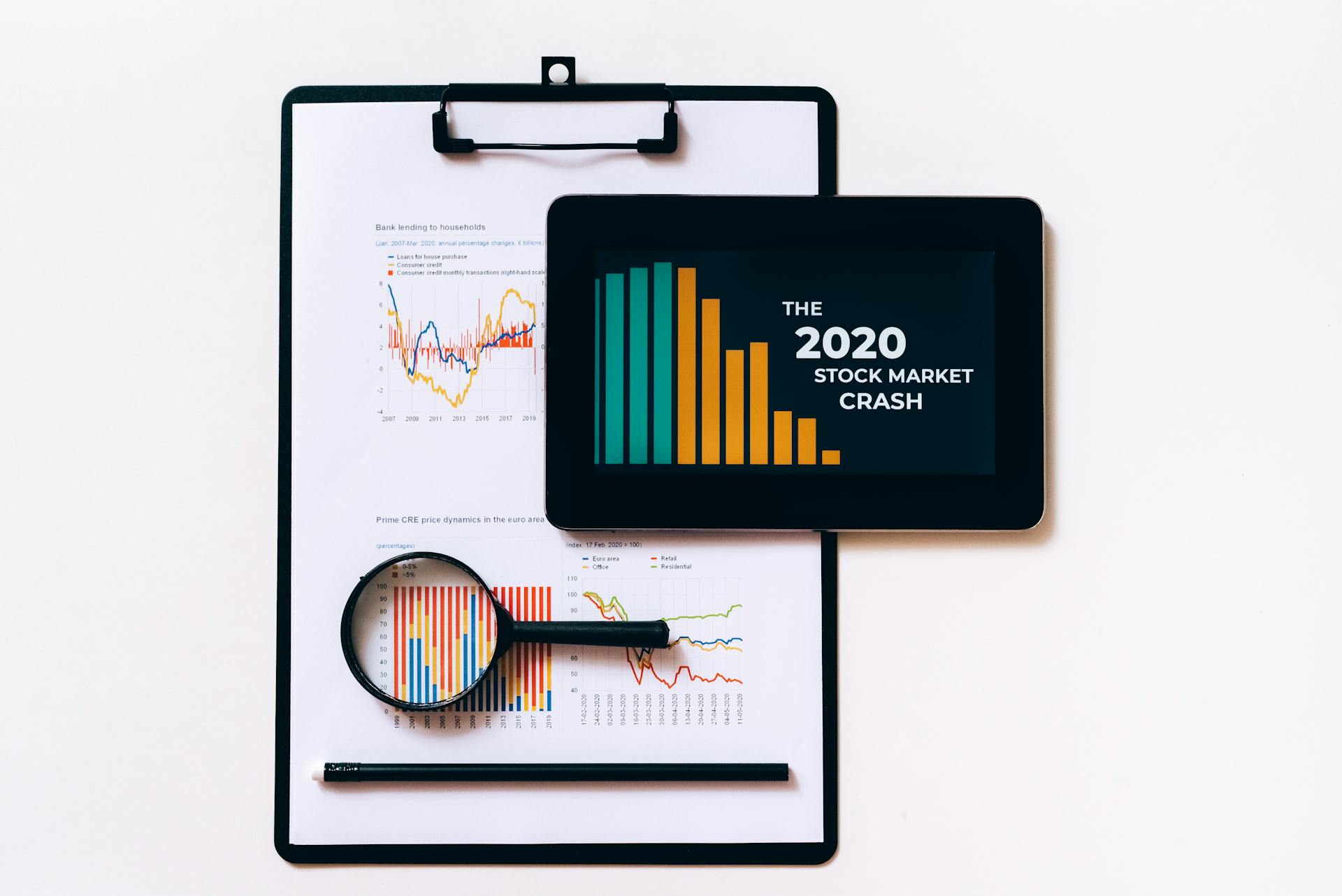
Stock valuation is a crucial aspect of investing, and understanding intrinsic value is a key part of it.
Intrinsic value is the true worth of a company, and it's calculated by estimating the present value of its future cash flows. According to the discounted cash flow model, a company's intrinsic value is the sum of its projected cash flows divided by the discount rate.
A company's intrinsic value can be higher or lower than its market value, and it's essential to understand this difference to make informed investment decisions. The intrinsic value of a company can be affected by its growth prospects, profitability, and industry trends.
Understanding intrinsic value is just one part of the stock valuation process. Other factors, such as market value, book value, and earnings per share, also play a crucial role in determining a company's true worth.
You might like: Market Value Added
What is Stock Valuation?
Stock valuation is a method of determining a stock's intrinsic value, or its theoretical value. This value can be different from the stock's current market price.
Knowing a stock's intrinsic value is crucial for investors who want to beat the market. By understanding the intrinsic value, an investor can determine if a stock is over- or undervalued.
Investors who master the skill of stock valuation have a significant advantage in the market.
On a similar theme: Stock Investor
Types of Valuation Methods
There are several types of valuation methods that investors can use to determine the intrinsic value of a stock.
The comparables method looks at companies in the same size and industry to determine a fair value for a company or asset. This approach is often synonymous with relative valuation in investments.
You can also use the past transaction method, which looks at past transactions of similar companies to determine an appropriate value.
An asset-based valuation method adds up all the company's asset values to get the intrinsic value, assuming they were sold at fair market value. This method wouldn't be suitable for valuing a consulting company with few assets, however.
Here's a quick rundown of the different valuation methods:
Valuation Models
Valuation models are a crucial part of stock valuation, and there are two main types: absolute and relative valuation models.
Absolute valuation models attempt to find the intrinsic or "true" value of an investment based only on fundamentals, such as dividends, cash flow, and growth rate. This type of model includes the dividend discount model, discounted cash flow model, residual income model, and asset-based model.
A different take: Project Finance Model
Relative valuation models, on the other hand, operate by comparing the company in question to other similar companies. These methods involve calculating multiples and ratios, such as the price-to-earnings multiple, and comparing them to the multiples of similar companies.
Here are some key characteristics of absolute and relative valuation models:
DDM
The Dividend Discount Model (DDM) is a fundamental technique in absolute stock valuation. It's based on the assumption that a company's dividends represent its cash flows to shareholders.
The DDM states that a stock's intrinsic value equals the present value of its future dividends. This model is only applicable if a company distributes dividends regularly and the distribution is predictable.
Investors use the DDM to value stocks that pay consistent dividends. It's a useful tool for investors who want to estimate a stock's fair value.
Here are some key characteristics of the DDM:
- It's an absolute valuation model, meaning it focuses on a single company's fundamentals.
- It's based on the assumption that dividends represent a company's cash flows to shareholders.
- It's only applicable to companies that distribute dividends regularly and predictably.
The DDM is a starting point for investors who want to estimate a stock's intrinsic value. It's a simple yet effective model that can help investors make informed decisions.
Discounted Cash Flow Model
The Discounted Cash Flow Model is a popular method of absolute stock valuation. It's used to calculate the intrinsic value of a stock by discounting the company's free cash flows to their present value.
This method doesn't require any assumptions regarding the distribution of dividends, making it suitable for companies with unknown or unpredictable dividend distributions. It's also more sophisticated from a technical perspective.
The DCF model is an example of an absolute valuation model, which focuses only on the fundamentals of a single company, such as dividends, cash flow, and growth rate. It's one of the valuation methods used to estimate the intrinsic value of a stock, along with relative valuation.
A key advantage of the DCF model is that it takes into account the cash inflows and outflows generated by the asset, providing a more comprehensive picture of the company's financial health. This approach is used in pricing stocks, such as with dividend discount models like the Gordon growth model.
A fresh viewpoint: Dcf Enterprise Value
Here are some key characteristics of the DCF model:
- Discounts cash flows to present value
- Does not require dividend distribution assumptions
- More sophisticated from a technical perspective
- Used in absolute stock valuation
- Can be used in pricing stocks, such as with dividend discount models
By using the DCF model, analysts can estimate the intrinsic value of a stock and determine whether it's overvalued or undervalued by the market. This information can be useful for investors and analysts looking to make informed decisions about their investments.
Key Metrics for Valuation
Understanding P/E ratios is crucial for assessing stock value. This metric is used to compare stocks in similar industries, and it's essential to consider factors that aren't easily quantified, like a company's economic moat and its relative cost advantages.
Investors use the P/E and PEG ratios to compare stocks, but it's also important to consider other valuation metrics, such as the price/sales (P/S) ratio. The P/S ratio is equal to a company's market capitalization divided by its annual revenue.
Here are some key metrics for valuation:
- P/E ratio: a comparison of a company's stock price to its earnings per share
- PEG ratio: a comparison of a company's P/E ratio to its growth rate
- Price/sales (P/S) ratio: a comparison of a company's market capitalization to its annual revenue
These metrics can help investors determine a company's intrinsic value and compare it to its current market price, but it's essential to remember that there is not just one way to value a stock.
Elevated Metrics
Many valuation metrics are currently at historic highs, indicating that the U.S. market is richly valued. This is according to famed investor Warren Buffett, who looks at the ratio of stock market valuation to U.S. GDP as a rough valuation gauge.
The ratio is currently double its long-term average, and most other metrics, such as price to current earnings and price to sales, tell a similar story.
Focusing on the price to sales (P/S) ratio, a common metric used to value stocks, we see that Amazon has a P/S ratio of 3.11, based on its market cap of $1.79 trillion and revenue of $575 billion.
Investors should be careful when comparing P/S ratios across different companies, as they can vary greatly depending on the industry and business model.
If this caught your attention, see: Apple Payout Ratio
Price/Book
Valuing a stock requires filtering relevant information from unnecessary noise. Investors need to know about common stock valuation techniques and their applicable scenarios.
The price-to-book ratio is a useful metric for valuing a stock or company. It's calculated by dividing the company's stock price by its book value per share.
Explore further: The Constant Growth Formula Calculates the Stock Price
A company's book value is equal to its assets minus its liabilities, found on its balance sheet. This metric is more relevant for evaluating asset-heavy businesses, such as banks and other financial institutions.
This metric is only marginally useful for evaluating companies with asset-light business models, like software tech companies.
Additional reading: What Are Asset Management Companies
Core Metrics for Valuing a Company
Valuing a company requires a solid understanding of key metrics. Understanding P/E ratios is crucial for assessing stock value.
Investors use P/E and PEG ratios to compare stocks in similar industries. These ratios help determine if a stock's price is high or low relative to its performance and growth projections.
A company's economic moat and relative cost advantages are also important factors to consider. These intangible assets can significantly impact a company's value.
Here are some of the most common metrics used for valuation:
- P/E (Price-to-Earnings) ratio
- PEG (Price-to-Earnings-to-Growth) ratio
- Enterprise value-to-EBITDA (EV/EBITDA) multiple
These metrics can be used to compare a company's value to its peers in the same industry. By analyzing these metrics, investors can make more informed decisions about whether to buy or sell a stock.
What Is Intrinsic Value?
Intrinsic value is a crucial concept in stock valuation, and it's essential to understand what it means. It's the real worth of a company's stock, based on its financial health and performance.
To calculate intrinsic value, we need to look beyond the stock's current market price, which can be influenced by people's opinions and emotions. Instead, we focus on the company's actual financial strength, like its earnings and debts.
The intrinsic value of a stock is not a fixed number, but rather a range that takes into account various factors. One way to estimate intrinsic value is to use the average of two valuation methods: DCF Valuation and Relative Valuation.
Here are the two valuation methods used to calculate intrinsic value:
- DCF Valuation
- Relative Valuation
By understanding intrinsic value, you can make better decisions about which stocks to buy and when. It's not a guarantee of success, but it helps you make more informed investment choices.
Market and Comparison
The market price of a stock can be deceiving, as it only shows what others are willing to pay. To get a more accurate picture, we need to look at the fair value, which is based on a company's actual financials.
Comparable companies analysis is a method of relative stock valuation that uses the price multiples of similar companies to derive a stock's theoretical price. This method is often used in conjunction with other valuation methods to get a more comprehensive view of a company's value.
Intrinsic value is the ultimate goal of stock valuation, and it's the only logical way to evaluate the relative attractiveness of investments and businesses. By understanding the different valuation methods, such as the comparable companies analysis and the precedent transaction method, investors can make more informed decisions about their investments.
Here are some of the most commonly used multiples in comparable companies analysis:
These multiples can help investors compare stocks in similar industries and make more informed decisions about their investments.
Expand your knowledge: Brk.b Shares Outstanding
Market
The market is a complex and ever-changing beast, and understanding how to value stocks is crucial for making informed investment decisions. Comparable companies analysis is a relative stock valuation method that uses the price multiples of similar companies to determine a stock's theoretical price.
Understanding P/E ratios is crucial for assessing stock value, and investors use P/E and PEG ratios to compare stocks in similar industries. The comparable company analysis looks at companies that are in the same size and industry to determine a fair value for a company or asset.
A company's economic moat is a durable competitive advantage that protects it from competitors and helps it sustain profitability over the long term. Companies like Johnson & Johnson, Mastercard Inc, and Salesforce Inc have demonstrated exceptional profitability and efficient operations.
The precedent transaction method compares the company being valued to other similar companies that have recently been sold. This method is often employed in mergers and acquisition transactions, and it's essential to find truly comparable companies to get an accurate valuation.
For another approach, see: Real Estate Asset Management Companies
Stock valuations can be affected by bond valuations, and in recent history, it was argued that the stock market should be at a relatively high valuation because bonds were trading at relatively high prices. The 10-year Treasury bond yield has fluctuated over time, and now it stands at over 4%, which is much closer to a historically normal level.
Here are some companies that have been frequently analyzed and tracked by Alpha Spread users:
U.S. Tech Prevalence
The U.S. tech sector is a significant player in the market, with many tech companies being considered asset light, robust, and well-managed businesses.
These companies are often seen as deserving a premium to less well-positioned and less agile companies of the past. However, it's worth noting that China has its own cutting-edge A.I. models, which challenges the notion that U.S. tech companies have a monopoly on innovation.
The high profits of U.S. tech businesses are a major factor in their valuation, but it's unclear how much of this strength is already reflected in their profits. This raises the question of whether paying a large valuation premium is, in a sense, double counting.
Earnings and Growth
Earnings per share (EPS) is an indicator of company profit, calculated by dividing earnings available to common shareholders by the number of common stock shares outstanding.
The price-to-earnings (P/E) ratio is a key metric in stock valuation, calculated by dividing the market price per share by EPS. A P/E ratio of 20 times earnings is considered relatively expensive.
Historically, stock market returns have tracked earnings growth, making it a reasonable strategy to simply stay invested in U.S. stocks over the long-term.
Swings in valuation can dominate earnings growth in the short-term, so it's essential to keep an eye on valuations.
The P/E ratio is a cornerstone metric in stock valuation, calculated by dividing the company's stock price by its most recently reported EPS. A low P/E ratio implies an attractive amount of value.
Walmart's P/E ratio, for example, was 29.24 in August 2024, based on a stock price of $68.13 and EPS of $2.33.
Curious to learn more? Check out: Earnings per Share Dilution
Limitations and Considerations
No one valuation method is best suited for every situation, and each stock is different with unique characteristics that can require multiple valuation methods.
Trying to time or predict the stock market is an almost impossible task, making it difficult to accurately value a stock.
U.S. stock valuations are at high levels compared to history, while international stock markets and fixed income offer more moderate valuation levels, making some diversification prudent.
Investors should consider companies' qualitative strengths and weaknesses, such as a defensible economic moat, large user bases, and relative cost advantages, when gauging a stock's value.
Limitations
It's easy to become overwhelmed by the number of valuation techniques available to investors. Some valuation methods are fairly straightforward.
Unfortunately, no one method is best suited for every situation. Each stock is different and each industry or sector has unique characteristics that can require multiple valuation methods.
Different valuation methods will produce different values for the same underlying asset or company. This can lead analysts to employ the technique that provides the most favorable output.
Factors to Consider
Timing the stock market is a nearly impossible task, and even experts can't predict its short-term moves. This unpredictability can actually be a major factor in a stock's long-term outperformance.
U.S. stock valuations are currently at high levels compared to history, making it a good idea to be cautious. International markets and fixed income, on the other hand, offer more moderate valuation levels.
Investors should consider qualitative strengths and weaknesses when evaluating a company's value, rather than just relying on numbers. A company with a defensible economic moat, for example, can better compete with new market participants.
Companies with large user bases benefit from network effects, and those with a relative cost advantage are likely to be more profitable. High-quality companies often have intangible assets like patents, regulations, and brand recognition that add value.
Here are some key factors to consider when evaluating a stock:
- Companies with a defensible economic moat can better compete with new market participants.
- Companies with large user bases benefit from network effects.
- Companies with a relative cost advantage are likely to be more profitable.
- High-quality companies often have intangible assets like patents, regulations, and brand recognition that add value.
It's also essential to be aware of value traps, which can appear cheap but are actually not. These types of stocks often have deteriorating business conditions and can be a major risk for investors.
Valuation Methods and Examples
Valuing a stock can be a complex process, but it's essential for investors to understand the different methods available. Investors need to be able to filter relevant information from unnecessary noise.
There are various ways to do a valuation, including the comparable company analysis, which looks at companies in the same size and industry to determine a fair value. This approach is often synonymous with relative valuation in investments.
The comparable company analysis is useful when comparing stocks in similar industries. It's essential to consider factors that aren't easily quantified, like a company's economic moat and its relative cost advantages.
The precedent transaction method compares a company to similar companies that have recently been sold. This comparison works best if the companies are in the same industry.
Here are some common valuation methods:
- Comparable company analysis
- Precedent transaction method
- Asset-based valuation method
- Earnings-based approach (like the DCF)
Each method has its own strengths and weaknesses, and some are more suitable for certain industries. For example, an asset-based approach wouldn't be suitable for valuing a consulting company with few assets.
Additional Metrics and Concepts

Valuing a stock requires more than just looking at the price. Understanding P/E ratios is crucial for assessing stock value, and investors use P/E and PEG ratios to compare stocks in similar industries.
Investors also consider factors that aren't easily quantified, like a company's economic moat and its relative cost advantages. These intangible factors can greatly impact a company's long-term success.
Other valuation metrics can be used to estimate the value of a stock or a company. Some metrics are more suitable for certain types of companies.
Here are some additional metrics to consider:
- P/E ratio: a comparison of a company's stock price to its earnings per share
- PEG ratio: a comparison of a company's P/E ratio to its growth rate
- Economic moat: a sustainable competitive advantage that sets a company apart from its competitors
- Relative cost advantages: a company's ability to produce goods or services at a lower cost than its competitors
The Bottom Line
Valuation is a complex process, but at its core, it's about determining the fair value of an asset or investment.
There are two main ways to value a company: on an absolute basis or relative to other similar companies or assets. This means you can look at a company's value in isolation or compare it to its peers.

Several methods and techniques can be used to arrive at a valuation, and each one may produce a different value. This is why it's essential to consider multiple approaches when evaluating a company's worth.
Valuations can be quickly impacted by corporate earnings or economic events, forcing analysts to retool their valuation models. This is why it's crucial to stay up-to-date on market trends and adjust your valuation accordingly.
Valuation involves both quantitative and subjective elements, requiring analysts to make assumptions and judgments about a company's value.
Take a look at this: Why Is Humminbird Out of Stock?
Frequently Asked Questions
What is the best valuation method?
There isn't a single "best" valuation method, as different approaches suit different situations. Business valuation professionals often use a combination of methods, such as DCF and comparable transactions, to get a comprehensive picture of a company's value.
What is the difference between valuation and stock price?
Valuation is an estimate of a stock's worth, considering factors like assets, earnings, and market conditions, whereas stock price is the current market value. Understanding the difference between valuation and stock price is crucial for making informed investment decisions.
Sources
- https://corporatefinanceinstitute.com/resources/valuation/stock-valuation/
- https://www.fool.com/investing/how-to-invest/stocks/how-to-value-stock/
- https://www.alphaspread.com/intrinsic-value-calculator
- https://www.investopedia.com/terms/v/valuation.asp
- https://www.forbes.com/sites/simonmoore/2024/12/16/us-stock-valuations-are-elevated-heres-why-that-matters/
Featured Images: pexels.com


